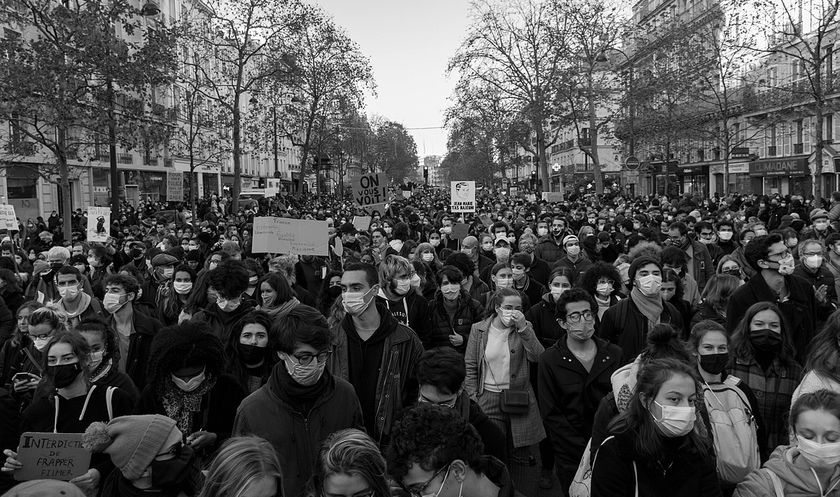Kelly Bellin is a member of Socialist Alternative in the US.
 A new women’s movement is emerging in the US and internationally in the context of major threats to women’s hard won gains from vicious reactionary forces. Donald Trump’s election victory drove millions to the streets, and has further radicalized a section of society on the basis of fighting sexism. In Brazil, women are playing a crucial role in the #EleNao movement against Jair Bolsonaro, the despicable misogynist who has come to power at a time of devastating economic, social, and political crisis. The democratic rights of women, black Brazilians, the LGBTQ community, indigenous people, and the entire working class are on the line under a Bolsonaro administration.
The #MeToo campaign brought sexual harassment and assault front and center in society, not only in the U.S. but internationally. On top of this the Great Recession, as well as the attacks from the right, have detonated a series of explosive struggles in recent years. These have politicized many young and working-class women who have been disproportionately affected by the crisis of capitalism. Young women also played a key role in Bernie Sanders’ campaign in 2016 which pointed toward a real challenge to the corporate power which benefits from sexism and racism.
Even before millions protested the Predator in Chief, the mood to fight sexism had reached a boiling point. From the Slutwalk protests, to Carry That Weight, to #YesAllWomen, young women made clear that they were ready to fight back against sexism and abuse. Millions of women want to not only fight back against their own Weinsteins and Kavanaughs, but to end the endemic sexism which permeates through all of our lives.
As the right wing continues to carry out attacks on women, LGBTQ people, people of color, immigrants, unions, and all working people, the new women’s movement is faced with decisive questions. How can we fight the right? Who are we fighting for? And how do we build a movement that can both defeat these immediate attacks and go on to win real gains for women?
#MeToo and the Fight against Kavanaugh
Brett Kavanaugh’s nomination to the Supreme Court became symbolic of the overall fight against sexual harassment and assault, with nearly 6-in-10 Americans having followed the Senate Judiciary Committee proceeding closely. Since its inception, #MeToo has taken down a series of powerful men who were exposed as misogynists and abusers. Yet this time, aided by the weakness of the Democrats’ approach, the Republicans’ ferocious campaign succeeded..
Kavanaugh’s appointment represents a direct threat to reproductive rights, LGBTQ rights, voting rights, environmental protections, and workers’ rights generally. Before Christine Blasey Ford courageously came forward, the Democratic leadership had basically accepted that this was a done deal and they would make only a show of opposition. While they changed their approach once the nation’s attention was squarely focused on Kavanaugh’s past abuse, they still refused to lead the kind of battle that could have actually defeated the Republicans.
The Democratic leadership could have mobilized protests and direct actions to bring the full force of mass outrage at Kavanaugh, focusing not just on his predatory behavior but using this as a way of mobilizing against the entire reactionary Republican agenda. But this is precisely what they won’t do because, while they are happy to use identity politics for electoral purposes, they live in fear of any real mass movement whose demands would go beyond what is acceptable to their corporate donors.
The backlash to Kavanaugh’s nomination shows the potential, and the need, to develop the new women’s movement into a truly mass force that gives concrete expression to the broad mood to fight back against sexism and in defense of our rights. In addition, the outcome shows that the movement cannot rely on the Democratic Party’s willingness to take action. The movement, starting from taking on harassment in the workplace, must also take on all the issues that affect working-class women. It must fight for health care for all, education for all, housing for all, and squarely take up each and every attack on working people.
While millions turned out in the midterm elections this year and voted for the Democrats as a way of pushing back against Trump and the Republican Party, millions also see the need for a new political force. At the same time there is a palpable mood in society to end sexism, racism, and the deep inequality which ravages our communities.
Lessons of Past Struggles
To wage our struggle today, it is crucial that we learn from the heroic women’s struggles of the past as well as all the struggles against oppression. The women’s movement of the ‘60s and ‘70s coincided with an era of massive social upheavals, from the Civil Rights movement to the movement against the Vietnam War as well as an enormous upsurge of labor struggle. Women, people of color, LGBTQ people, and workers broadly were emboldened to take their fight against oppression and inequality to higher levels of organization and action.
At the same time, women entered the workforce in large numbers in the ’60s and ’70s, and were part of a demographic transformation of the US working class that also included new industries and job categories opening to black workers and other racial minorities. Working-class women organized and fought for equality and respect on the job as well as in their families and communities, which made feminism a genuine current in the working class. This was the engine of changing attitudes about women on a mass level, one of the most crucial gains from this period.
Unfortunately, the leadership of mainstream women’s organizations failed to build off the movement’s momentum by unabashedly fighting for a pro-working-class program that could have mobilized even broader sections of society. Organizations like NOW and NARAL did not aim to confront capitalism as a whole, and therefore refused to build the kind of movement necessary to end sexism. In the interest of appearing acceptable to the “mainstream” of society, NOW’s leadership even consciously pushed away radicals. As a consequence, the movement’s failure to adopt a clear program that could speak to the interests and needs of working-class women and women of color limited its appeal, even while its campaigns had a positive impact on popular opinion and won some important gains.
Many of the historic tasks of the struggles of the ‘60s and ‘70s remain to be completed, but the lessons from that time are pivotal for the new women’s movement. The limitations of the past women’s rights movements expose that the question of class is decisive for struggle. Liberal feminism, and the organizations led by it, may fight for sweeping reforms but will ultimately defend the system that keeps women, LGBTQ people, people of color, immigrants, and all working-class people under varying levels of oppression. A socialist feminist trend in the women’s movement is crucial for not allowing the misleadership of liberal, pro-capitalist feminism to hold back movements that have the potential to genuinely challenge the status quo.
Multi-Gender Workplace Actions Against Sexual Harassment
#MeToo ignited a mass discussion about the need to end sexual harassment, in particular in our workplaces. And while the first year of the #MeToo moment was primarily expressed through online and interpersonal discussion, not through mass demonstrations, it already contained the power to take down high-profile abusers. For millions of ordinary women, this gave us confidence that our own abusers could also be confronted and that a world in which Weinsteins cannot reach such levels of success at all is actually possible.
In the last few months, workers at some of the largest global corporations have shown the way forward for bringing #MeToo into our workplaces and the potential for building class-based struggles against sexism. In September, McDonald’s workers carried out the first-ever nationwide strike against sexual harassment on the job in 10 cities across the US including Chicago, San Francisco, L.A., and New Orleans. In part inspired by that strike action, on November 1, Google workers staged an international walkout against sexual harassment, with 20,000 participating.
In fact, the growing labor upsurge in the U.S. has been spearheaded by heavily female workforces including nurses and teachers. The teachers’ revolt this past spring was also a revolt against years of a vicious and essentially sexist campaign that sought to blame teachers for society’s problems. The teachers in West Virginia, Arizona, Oklahoma, and North Carolina rose up to defend themselves, their students and their communities.
A notable feature of the Google employee walkout was the number of men who walked off the job to fight sexual harassment. This is a reflection of the overall shift in consciousness, especially among young people. People of all genders, in growing numbers, reject sexism and want to join the broader fight against the bosses. The walkout of Google workers closed, or partially closed, 40 offices around the world, breaking open a new stage of the fight against sexual harassment as well as representing the first concrete steps toward workplace self-organization among tech workers.
In late October, city employees in Glasgow, Scotland carried out the largest strike action for equal pay in British history. Women made up 90% of the strikers, which reached 10,000 workers on the first day and inspired mass participation in their communities. Pickets were set up in front of hundreds of schools and municipal buildings, which helped gain even more mass support and solidarity. Following this, the mostly-male sanitation workers carried out a solidarity strike action which completely shut down sanitation services in Glasgow. Having a male-dominated workforce willing to stand in solidarity with women workers fighting for equal pay was a tremendous boost to the strike and its political impact.
At the cross-section of a rising labor and women’s movements, these workers have shown how the fight against harassment must be brought to the workplace to take on the everyday sexism that we face. A mass movement that takes to the streets and builds effective organization in the workplaces, where working people have enormous potential social power if they take collective action, can disrupt the status quo and challenge abusive bosses and systemic inequality. At the end of the day it’s the whole system of legalized exploitation and abuse called capitalism that needs to be brought to an end.
Socialists believe that to ultimately achieve women’s liberation we need to build a new society. Most importantly, we believe that it’s possible. Every successful struggle that we organize against right-wing attacks on women, LGBTQ people, immigrants, people of color, and unions and every reform we can win under capitalism builds confidence for working people to unite and fight for our liberation and an egalitarian socialist world.
A new women’s movement is emerging in the US and internationally in the context of major threats to women’s hard won gains from vicious reactionary forces. Donald Trump’s election victory drove millions to the streets, and has further radicalized a section of society on the basis of fighting sexism. In Brazil, women are playing a crucial role in the #EleNao movement against Jair Bolsonaro, the despicable misogynist who has come to power at a time of devastating economic, social, and political crisis. The democratic rights of women, black Brazilians, the LGBTQ community, indigenous people, and the entire working class are on the line under a Bolsonaro administration.
The #MeToo campaign brought sexual harassment and assault front and center in society, not only in the U.S. but internationally. On top of this the Great Recession, as well as the attacks from the right, have detonated a series of explosive struggles in recent years. These have politicized many young and working-class women who have been disproportionately affected by the crisis of capitalism. Young women also played a key role in Bernie Sanders’ campaign in 2016 which pointed toward a real challenge to the corporate power which benefits from sexism and racism.
Even before millions protested the Predator in Chief, the mood to fight sexism had reached a boiling point. From the Slutwalk protests, to Carry That Weight, to #YesAllWomen, young women made clear that they were ready to fight back against sexism and abuse. Millions of women want to not only fight back against their own Weinsteins and Kavanaughs, but to end the endemic sexism which permeates through all of our lives.
As the right wing continues to carry out attacks on women, LGBTQ people, people of color, immigrants, unions, and all working people, the new women’s movement is faced with decisive questions. How can we fight the right? Who are we fighting for? And how do we build a movement that can both defeat these immediate attacks and go on to win real gains for women?
#MeToo and the Fight against Kavanaugh
Brett Kavanaugh’s nomination to the Supreme Court became symbolic of the overall fight against sexual harassment and assault, with nearly 6-in-10 Americans having followed the Senate Judiciary Committee proceeding closely. Since its inception, #MeToo has taken down a series of powerful men who were exposed as misogynists and abusers. Yet this time, aided by the weakness of the Democrats’ approach, the Republicans’ ferocious campaign succeeded..
Kavanaugh’s appointment represents a direct threat to reproductive rights, LGBTQ rights, voting rights, environmental protections, and workers’ rights generally. Before Christine Blasey Ford courageously came forward, the Democratic leadership had basically accepted that this was a done deal and they would make only a show of opposition. While they changed their approach once the nation’s attention was squarely focused on Kavanaugh’s past abuse, they still refused to lead the kind of battle that could have actually defeated the Republicans.
The Democratic leadership could have mobilized protests and direct actions to bring the full force of mass outrage at Kavanaugh, focusing not just on his predatory behavior but using this as a way of mobilizing against the entire reactionary Republican agenda. But this is precisely what they won’t do because, while they are happy to use identity politics for electoral purposes, they live in fear of any real mass movement whose demands would go beyond what is acceptable to their corporate donors.
The backlash to Kavanaugh’s nomination shows the potential, and the need, to develop the new women’s movement into a truly mass force that gives concrete expression to the broad mood to fight back against sexism and in defense of our rights. In addition, the outcome shows that the movement cannot rely on the Democratic Party’s willingness to take action. The movement, starting from taking on harassment in the workplace, must also take on all the issues that affect working-class women. It must fight for health care for all, education for all, housing for all, and squarely take up each and every attack on working people.
While millions turned out in the midterm elections this year and voted for the Democrats as a way of pushing back against Trump and the Republican Party, millions also see the need for a new political force. At the same time there is a palpable mood in society to end sexism, racism, and the deep inequality which ravages our communities.
Lessons of Past Struggles
To wage our struggle today, it is crucial that we learn from the heroic women’s struggles of the past as well as all the struggles against oppression. The women’s movement of the ‘60s and ‘70s coincided with an era of massive social upheavals, from the Civil Rights movement to the movement against the Vietnam War as well as an enormous upsurge of labor struggle. Women, people of color, LGBTQ people, and workers broadly were emboldened to take their fight against oppression and inequality to higher levels of organization and action.
At the same time, women entered the workforce in large numbers in the ’60s and ’70s, and were part of a demographic transformation of the US working class that also included new industries and job categories opening to black workers and other racial minorities. Working-class women organized and fought for equality and respect on the job as well as in their families and communities, which made feminism a genuine current in the working class. This was the engine of changing attitudes about women on a mass level, one of the most crucial gains from this period.
Unfortunately, the leadership of mainstream women’s organizations failed to build off the movement’s momentum by unabashedly fighting for a pro-working-class program that could have mobilized even broader sections of society. Organizations like NOW and NARAL did not aim to confront capitalism as a whole, and therefore refused to build the kind of movement necessary to end sexism. In the interest of appearing acceptable to the “mainstream” of society, NOW’s leadership even consciously pushed away radicals. As a consequence, the movement’s failure to adopt a clear program that could speak to the interests and needs of working-class women and women of color limited its appeal, even while its campaigns had a positive impact on popular opinion and won some important gains.
Many of the historic tasks of the struggles of the ‘60s and ‘70s remain to be completed, but the lessons from that time are pivotal for the new women’s movement. The limitations of the past women’s rights movements expose that the question of class is decisive for struggle. Liberal feminism, and the organizations led by it, may fight for sweeping reforms but will ultimately defend the system that keeps women, LGBTQ people, people of color, immigrants, and all working-class people under varying levels of oppression. A socialist feminist trend in the women’s movement is crucial for not allowing the misleadership of liberal, pro-capitalist feminism to hold back movements that have the potential to genuinely challenge the status quo.
Multi-Gender Workplace Actions Against Sexual Harassment
#MeToo ignited a mass discussion about the need to end sexual harassment, in particular in our workplaces. And while the first year of the #MeToo moment was primarily expressed through online and interpersonal discussion, not through mass demonstrations, it already contained the power to take down high-profile abusers. For millions of ordinary women, this gave us confidence that our own abusers could also be confronted and that a world in which Weinsteins cannot reach such levels of success at all is actually possible.
In the last few months, workers at some of the largest global corporations have shown the way forward for bringing #MeToo into our workplaces and the potential for building class-based struggles against sexism. In September, McDonald’s workers carried out the first-ever nationwide strike against sexual harassment on the job in 10 cities across the US including Chicago, San Francisco, L.A., and New Orleans. In part inspired by that strike action, on November 1, Google workers staged an international walkout against sexual harassment, with 20,000 participating.
In fact, the growing labor upsurge in the U.S. has been spearheaded by heavily female workforces including nurses and teachers. The teachers’ revolt this past spring was also a revolt against years of a vicious and essentially sexist campaign that sought to blame teachers for society’s problems. The teachers in West Virginia, Arizona, Oklahoma, and North Carolina rose up to defend themselves, their students and their communities.
A notable feature of the Google employee walkout was the number of men who walked off the job to fight sexual harassment. This is a reflection of the overall shift in consciousness, especially among young people. People of all genders, in growing numbers, reject sexism and want to join the broader fight against the bosses. The walkout of Google workers closed, or partially closed, 40 offices around the world, breaking open a new stage of the fight against sexual harassment as well as representing the first concrete steps toward workplace self-organization among tech workers.
In late October, city employees in Glasgow, Scotland carried out the largest strike action for equal pay in British history. Women made up 90% of the strikers, which reached 10,000 workers on the first day and inspired mass participation in their communities. Pickets were set up in front of hundreds of schools and municipal buildings, which helped gain even more mass support and solidarity. Following this, the mostly-male sanitation workers carried out a solidarity strike action which completely shut down sanitation services in Glasgow. Having a male-dominated workforce willing to stand in solidarity with women workers fighting for equal pay was a tremendous boost to the strike and its political impact.
At the cross-section of a rising labor and women’s movements, these workers have shown how the fight against harassment must be brought to the workplace to take on the everyday sexism that we face. A mass movement that takes to the streets and builds effective organization in the workplaces, where working people have enormous potential social power if they take collective action, can disrupt the status quo and challenge abusive bosses and systemic inequality. At the end of the day it’s the whole system of legalized exploitation and abuse called capitalism that needs to be brought to an end.
Socialists believe that to ultimately achieve women’s liberation we need to build a new society. Most importantly, we believe that it’s possible. Every successful struggle that we organize against right-wing attacks on women, LGBTQ people, immigrants, people of color, and unions and every reform we can win under capitalism builds confidence for working people to unite and fight for our liberation and an egalitarian socialist world. 



